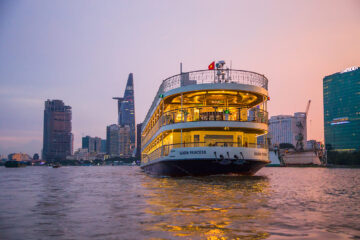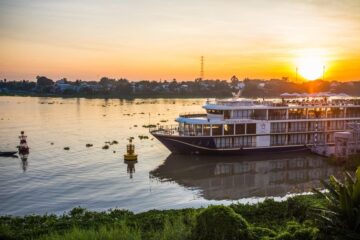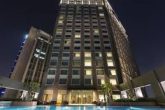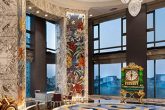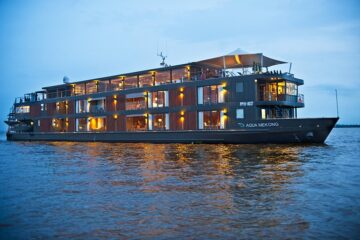Hotline: +84 913223338 - [email protected]

BEST OF INDOCHINA TOUR
- 15days/14nights
- VIENTIANE – LUANGPRABANG - PAK OU CAVE - HANOI - HALONG BAY – HUE – HOIAN – HO CHI MINH - MEKONG – CU CHI TUNNEL - PHNOM PENH - SIEM REAP
-
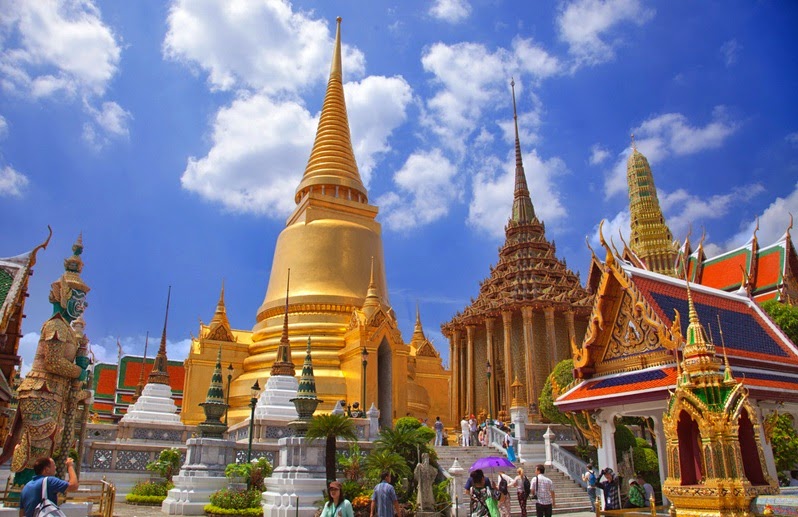 Day 1: Vientiane - Arrival (D)
Day 1: Vientiane - Arrival (D)Meals: Dinner at local restaurant
Accommodations at hotel
Transfer: Private vehicle
Activities for today: Upon arrival, you are met and transferred to your centrally located hotel. After a short rest, we start to visit the major sights of the capital; including the oldest Wat Sisaket with thousands of miniature Buddha statues and the former royal temple of Wat Prakeo previously housed the famous Emerald Buddha Image. On the way to the famous and sacred structure of That Luang Stupa, we stop to take some pictures of the imposing Patuxai Monument, which is well known as Vientiane’s own Arc de Triumph. From there, we visit the Central Market call ‘Morning Market’ where you can find the antique items for collection, well handmade textile and gift away items. Overnight in Vientiane.
---------------------------------------------
+ Wat Si Saket is a Buddhist wat in Vientiane, Laos. It is situated on Lan Xang Road, on the corner with Setthathirat Road, to the northwest of Haw Phra Kaew, which formerly held the Emerald Buddha
+ Patuxai Monument: literally meaning Victory Gate or Gate of Triumph, formerly the Anousavary or Anosavari Monument, known by the French as Monument Aux Morts) is a war monument in the centre of Vientiane, Laos, built between 1957 and 1968. The Patuxai was dedicated to those who fought in the struggle for independence from France. In romanising the name from the Laotian language, it is variously transliterated as Patuxai, Patuxay, Patousai and Patusai. It is also called Patuxai Arch or the Arc de Triomphe of Vientiane as it resembles the Arc de Triomphe in Paris. However, it is typically Laotian in design, decorated with mythological creatures such as the kinnari (half-female, half-bird).
+ Talat Sao (Morning market): At the eastern corner of Lan Xang Rd. and Khu Vieng Rd. in the heart of Vientiane, the morning market is open daily from 07:00 until around 16:00. The market is two-storey and covered by several sloping roofs. It is a popular tourist destination. The market consists of many small shops, restaurants, fruit and vegetable vendors; jewellery; silk; wooden crafts; musical instruments; electronics; home appliances; housewares, CDs and DVDs/VCDs, and grocery items. Depending on the time of day and the weather conditions the market can be nearly empty or full to capacity
-
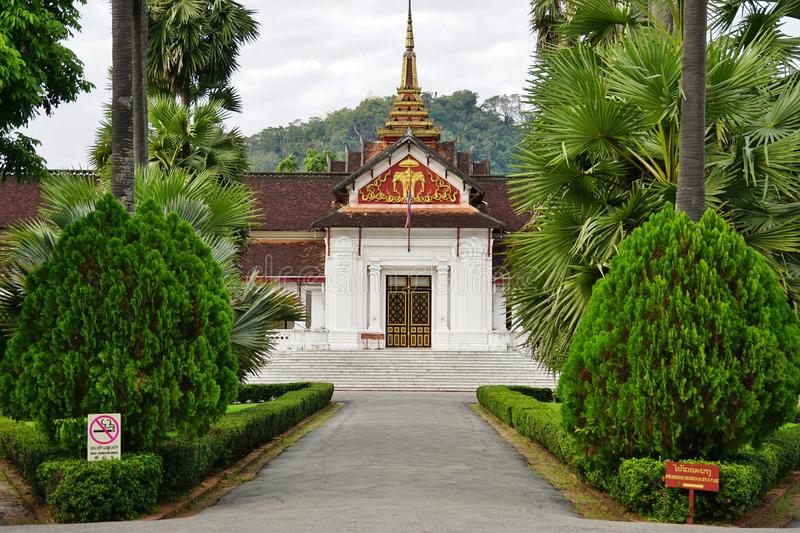 Day 2: Vientiane – Luang Prabang (B/L) by flight
Day 2: Vientiane – Luang Prabang (B/L) by flightMeals: Breakfast at hotel, Lunch at local restaurant
Accommodations at hotel
Transfer: Private vehicle and flight by Laos airline
Activities for today: Breakfast at hotel, we spend the day touring Lao capital, visiting the National Museum (Revolutionary Museum) where varied antique items and legend of Laos’s history fighters and leaders displace from the ancient times to new revolution period. We then board a short flight to Luang Prabang, which is perhaps the best - preserved traditional city in Southeast Asia. UNESCO registered 1995 as World Cultural Heritage City. The tranquility and charm of this town with its splendid natural scenery and cultural sights make it one of the most delightful places to visit in Asia. On arrival, we transfer you to hotel. After a short rest, we are strolling around to see the Street Night Market, where you can find the lovely collection and handmade textile by local and hill tribe people surrounding Luang Prabang, we then climb up to the top of Phousi Mount for an enjoyable exploration of the sacred, gilded stupa as well as viewing a beautiful panorama sunset over this once royal ancient city and the Mekong River. Overnight in Luang Prabang.
----------------------------------------------
+ The Lao National Museum is located in Vientiane, Laos. It was founded as the national museum highlighting the revolution of the 1970s and is located in a French colonial building. In 2007, the United States donated a grant to help develop the museum. The museum, which was originally built in 1925 as the French governor’s residence, presents the history of Laos, highlighting the Laotian people’s struggle to free the country from foreign occupiers and imperialist forces. It is located on Samsenthai road, opposite the Cultural Hall.
+ Luang Prabang night market is a must-experience. It’s an amazing sight and offers the most extensive collection of handicrafts in the country. With around 250 handicraft vendors who sell their hand-made products nightly, the market showcases an extensive variety of handicrafts made by local ethnic groups. On display are many types of textiles, exquisite ceramics, antiques, paintings, coffee and tea, quilts, shoes, silver, bags, ornaments and cutlery made from recycled bombs. There are a lot of interesting items on display at the night market that are hard to find elsewhere.
+ Phousi Mount, also written Mount Phu Si, is a 100 m high hill in the centre of the old town of Luang Prabang in Laos. It lies in the heart of the old town peninsula and is bordered on one side by the Mekong River and on the other side by the Nam Khan River. The hill is a local religious site, and houses are several Buddhist shrines.
Halfway up the hill, overlooking the Nam Khan is Wat Tham Phou Si, a Buddhist temple. At the summit of the hill, overlooking the town and surrounding countryside, is Wat Chom Si, which is also a Buddhist temple and is a tourist highlight of Luang Prabang.
+ Lao Airlines is the national airline of Laos, headquartered in Vientiane. It operates domestic as well as international services to countries such as Cambodia, China, Thailand, Vietnam, and Korea. Its main operating base is Wattay International Airport in Vientiane. It is subordinate to the Ministry of Public Works and Transport.
-
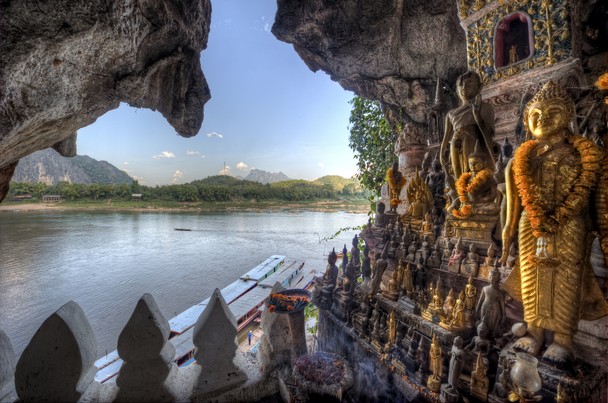 Day 3: Luang Prabang – Pak Ou cave (B/L)
Day 3: Luang Prabang – Pak Ou cave (B/L)Meals: Breakfast at hotel, Lunch at local restaurant
Accommodations at hotel
Transfer: Private vehicle
Activities for today: Breakfast, we enjoy a short-guided tour seeing the city’s oldest temple of impressive stupa of Wat Visoun and the shrine of Wat Aham, Wat Mai, Wat Sene and the magnificent Wat Xiengthong with its roofs sweeping low to the ground, which represent the classical architecture of Luang Prabang temple. We then board a boat embarking upstream on the Mekong River, which also gives us a beautiful view of the tranquil countryside as well as an interesting visit to the mysterious of Pak Ou Caves, crammed with thousands of gold lacquered Buddha statues of various shapes and sizes. Along the way, we stop at the village of Ban Xanghai, where they make the local rice wine. On return, We take a short drive to Ban Phanom, well known for its hand weaving. Overnight in Luang Prabang.
---------------------------------------------
+ Wat Visoun (Visounnalat): Built in 1512 or 1513, rebuilt in 1896-98 Wat Visounnalat was originally built during the reign of King Wisunarat (or Vixoun, 1501-1520) in 1513 (some suggest 1512) and represents the earliest style, sometimes referred to as Luang Prabang Style I, of Lao temple architecture. This style also includes the sims of Wat That Luang and Wat Mai. Wat Wisunalat is Luang Prabang’s oldest operating temple. As with the sims of most Lao wats, there are multiple roof structures. In the Style I form the first and second roofs extend around the entire perimeter of the structure. Except for the sim at Wat Mai, which was embellished by two additional gable roofs and two roofed side galleries, the style evokes simplicity, since the sim employs neither the high peaks of the gable nor the dramatic low sweeping roofs of many of the other sims of Luang Prabang. Located and adjoining Wat Aham to the southeast, it was probably built on the rice fields of the guardian spirits of the city (devata luang), Pu No and Na No (Phou Nheu and Nha Nheu). The sacred Prabang image was housed in the sim from 1513 until it was taken to Vientiane in 1707.
+ Wat Aham signifies "The Monastery of the Blossoming Heart". This temple was surely a place for mediation and meetings between spiritual culture and Buddhist practice. Neighbouring the Wat Vitsoun, it is relatively quiet even though the district has in the last few years, become the centre of Luang Prabang’s night life.
+ Wat Mai Suwannaphumaham often simply Wat Mai or Wat May is a Buddhist temple or wat in Luang Prabang, Laos. It is the largest and most richly decorated of the temples in Luang Prabang. Built in the 18th century, it is near the Royal Palace Museum. An emerald Buddha statue sits inside the red-gold interior.
+ Wat Xieng Thong ("Temple of the Golden City") is a Buddhist temple (wat) on the northern tip of the peninsula of Luang Phrabang, Laos. Wat Xieng Thong is one of the most important of Lao monasteries and remains a significant monument to the spirit of religion, royalty and traditional art. There are over 20 structures on the grounds including a sim, shrines, pavilions and residences, in addition to its gardens of flowers, ornamental shrubs, and trees.
+ Pak Ou Caves: Near Pak Ou (mouth of the Ou river) the Tham Ting (lower cave) and the Tham Theung (upper cave) are caves overlooking the Mekong River, 25 km to the north of Luang Prabang, Laos. They are a group of two caves on the west side of the Mekong river, about two hours upstream from the centre of Luang Prabang, and are frequently visited by tourists.
+ Ban Phanom is a village in Luang Prabang Province, Laos. It is located 6 kilometres (3.7 mi) east of Luang Prabang. The Lue peoples of this village are noted in particular for their cotton and silk weaving. Sale to tourists is now of prime importance to the local economy. Nearby is the Tomb of Mouhot, where Henri Mouhot lies.
-
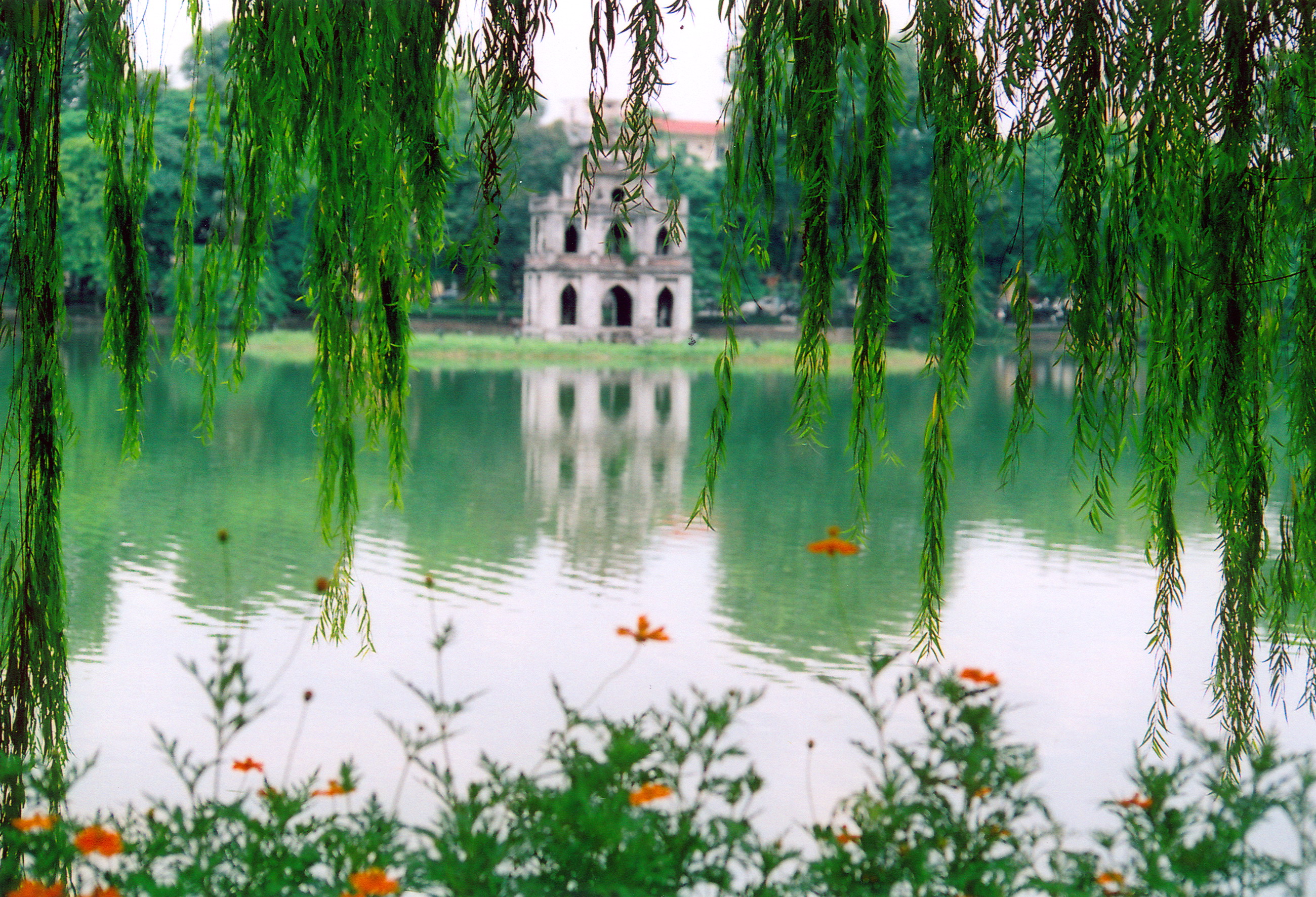 Day 4: Luang Prabang - Hanoi (B/L/D) by flight
Day 4: Luang Prabang - Hanoi (B/L/D) by flightMeals: Breakfast at hotel, Lunch and Dinner at local restaurant
Accommodations: at hotel
Transfer: Private vehicle
Activities for today: 06.00 Early this morning you may want to wake up early and participate in the daily early morning ritual of saffron-clad monks with their black Alms-giving bowls being given offerings from the local people, including the ubiquitous sticky rice. This is the highlight of tour prior goodbye to this charming city.
Breakfast, we then visit The National Museum at the former Royal Palace, which displays a lovely collection of the artifacts reflecting the richness of Lao culture dating from the days of the early kings right through the last sovereign. We continue visit the silver smith’s and Fine Arts School and the Central Market are not to be missed. We visit these sights before we catch a flight goodbye to this ancient city.
You are warmly welcomed by our Tour guide at Noibai Airport and transferred to your hotel in Hanoi capital. Be free and relax after long journey. In the evening, attend Water Puppet Show and enjoy welcome dinner. Overnight in Hanoi.
---------------------------------------------
+ The National Museum (former The Royal Palace) in Luang Prabang, Laos, was built in 1904 during the French colonial era for King Sisavang Vong and his family. The site for the palace was chosen so that official visitors to Luang Prabang could disembark from their river voyages directly below the palace and be received there. After the death of King Sisavang Vong, the Crown Prince Savang Vatthana and his family were the last to occupy the grounds. In 1975, the monarchy was overthrown by the communists and the royal family were taken to re-education camps. The palace was then converted into a national museum.
+ Water Puppet Show: It is a tradition that dates back as far as the 11th century CE when it originated in the villages of the Red River Delta area of northern Vietnam.
+ Lao Airlines is the national airline of Laos, headquartered in Vientiane. It operates domestic as well as international services to countries such as Cambodia, China, Thailand, Vietnam, and Korea. Its main operating base is Wattay International Airport in Vientiane. It is subordinate to the Ministry of Public Works and Transport.
-
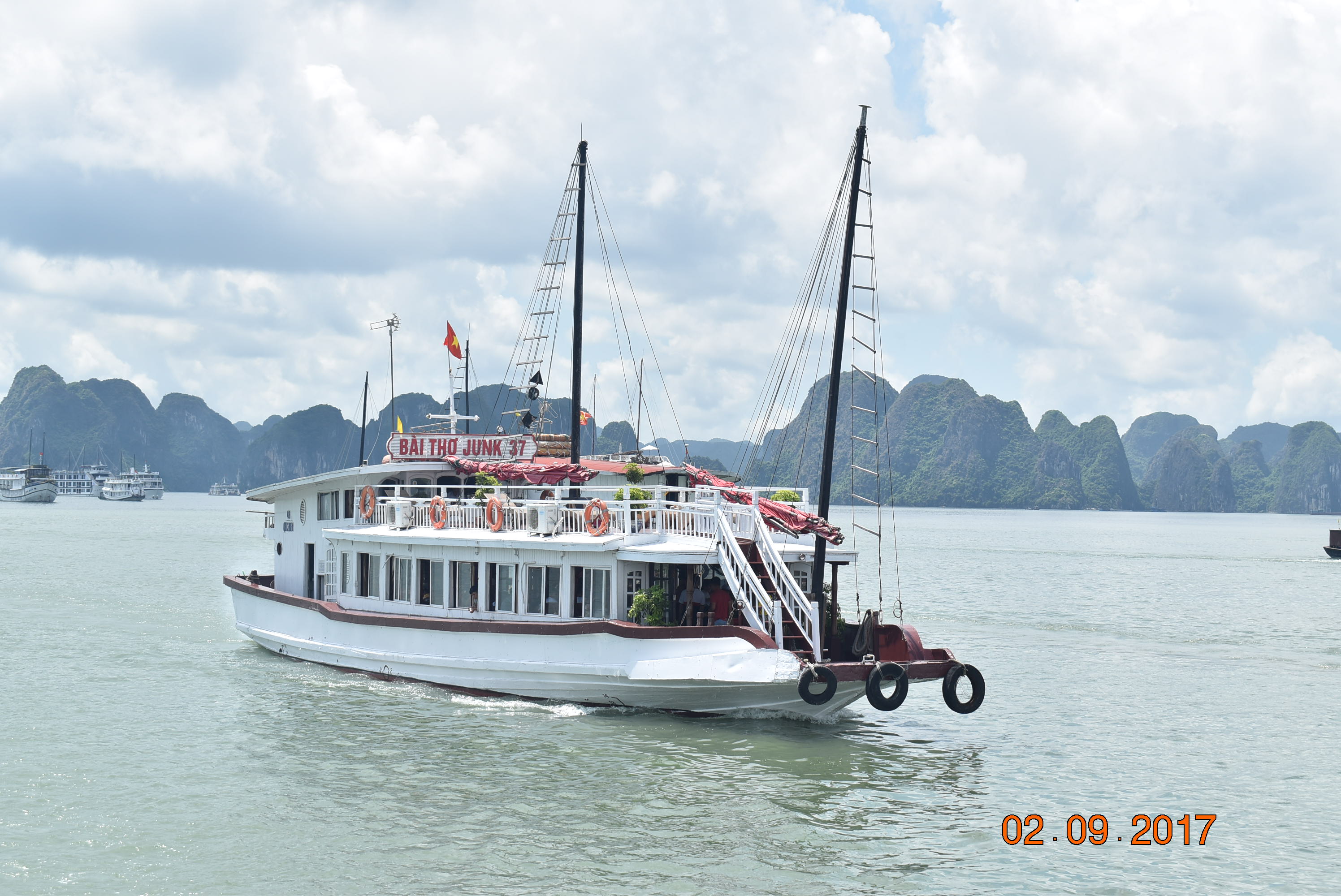 Day 5: Hanoi – Halong Bay - Hanoi (B/L)
Day 5: Hanoi – Halong Bay - Hanoi (B/L)Meals: Breakfast at hotel and Lunch on cruise
Accommodations: at hotel
Transfer: Private vehicle
Activities for today: After breakfast at hotel, leave Hanoi at 8:00 for Halong Bay, The World Heritage Area of outstanding natural beauty on the Ocean. Upon arrival, get on the private boat cruising around the islands, islets, caves and grottos. Enjoy seafood lunch on boat and take a short excursion to Thien Cung cave Or Dau Go cave. Drive back to Hanoi & overnight in Hanoi.
----------------------------------------------
+ HaLong Bay (Vịnh Hạ Long) is a UNESCO World Heritage Site and popular travel destination in Quang Ninh Province, Vietnam.
Ha Long Bay has an area of around 1,553 km2 (600 sq mi), including 1,960–2,000 islets, most of which are limestone. The core of the bay has an area of 334 km2 (129 sq mi) with a high density of 775 islets. The limestone in this bay has gone through 500 million years of formation in different conditions and environments. The evolution of the karst in this bay has taken 20 million years under the impact of the tropical wet climate. The geo-diversity of the environment in the area has created biodiversity, including a tropical evergreen bio system, oceanic and sea shore bio system. Ha Long Bay is home to 14 endemic floral species and 60 endemic faunal species.
+ Thien Cung cave: It is situated on the south-west side the bay, 4 km from the wharf outside of Ha Long City. The way to Thiên Cung is a perilous one, covered on both sides by thick forest. After entering a narrow gate, the grotto’s 130-meter-long girth opens up. Getting in we are more astonished in front of the very animated and splendid beauty which is made from stalactite. On the east wall of the grotto, there is a grandiose and imposing picture with characters of tales.
Going out of the Thiên Cung Grotto, we have a sensation of just watching a unique, meticulous, interesting fine-art museum which is made by nature, get out of the imagine, ability and intellect of man.
This grotto is recently discovered, one of the most beautiful grottoes in Ha Long Bay.
+ Dau Go Cave: The grotto is on Driftwood Island. Seen from afar, the entrance to the grotto appears to be blue, and has a shape similar to that of a jellyfish. After 90 steps up the island, the entrance is reached. The ceiling of the grotto is about 25 m. Hundreds of stalactites falling down from the roof of the grotto look like a waterfall. The grotto is divided into three main parts.
The exterior is a room with a vault full of natural light. Many forms may be seen in the rock formations of the chamber, depending on the imagination of the visitor of course.
Crossing the first chamber, one enters the second chamber through a narrow passage. The light here is mysterious, and new images appear in the stone. It makes us having a fear and be inquisitive.
The third chamber of the grotto is widely opened. At the end of the grotto is a well of clear water. Looking up in the dim light we recognize that surrounded is the image of an ancient citadel and a scuffle of elephants, horses, man with bristly sword and spear. All are making a rush and be petrified suddenly.
-
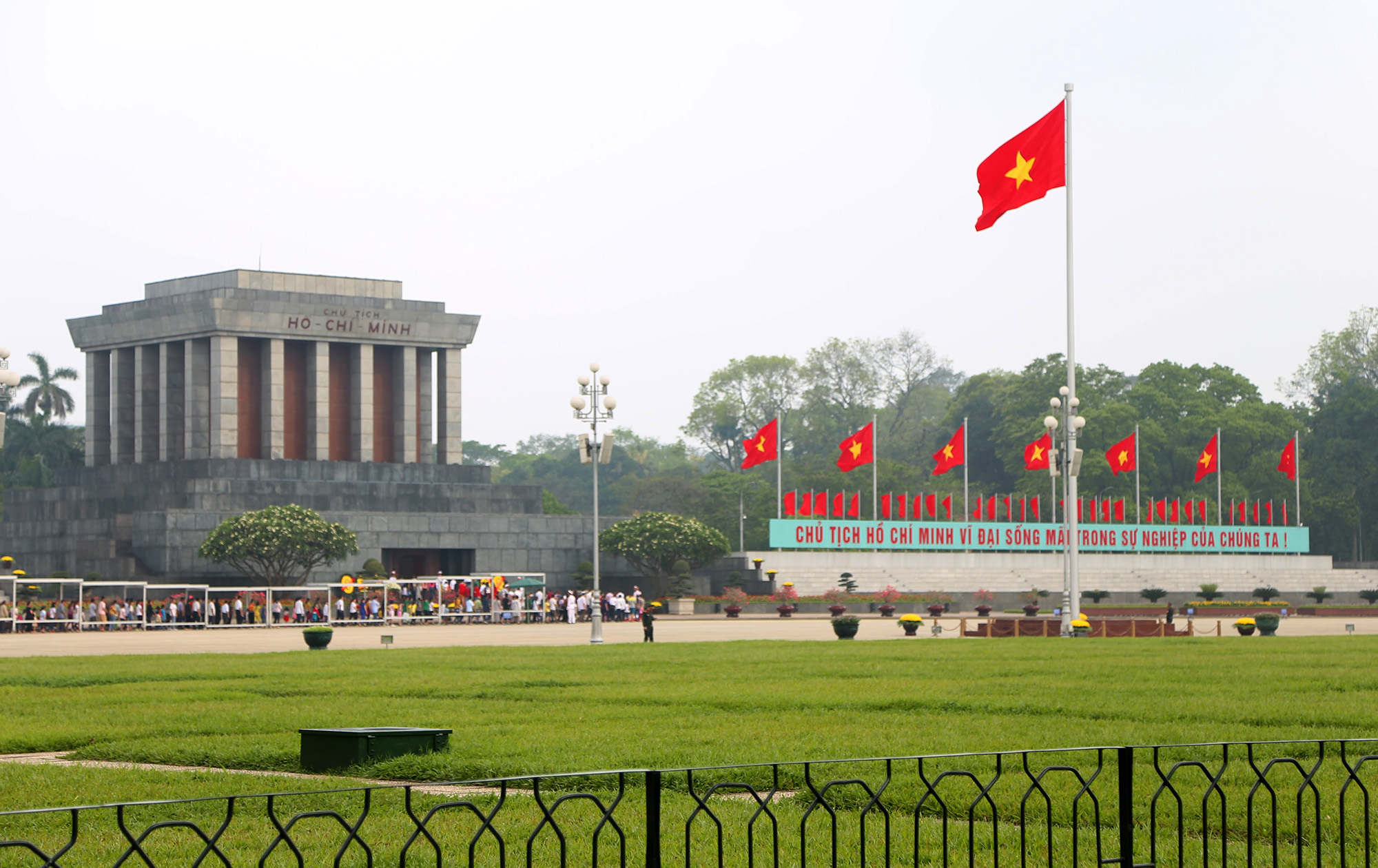 Day 6: Hanoi city tour - Hue (B/L) by flight
Day 6: Hanoi city tour - Hue (B/L) by flightMeals: Breakfast at hotel, Lunch at local restaurant
Accommodations: at hotel
Transfer: Private vehicle and flight by Vietnam airline
Activities for today: This morning, spent some leisure time on Ba Dinh Square, site of the Ho Chi Minh Mausoleum. Later, visit Ho Chi Minh's House on Stilts and the nearby One Pillar Pagoda, Temple of Literature-the first university of Vietnam. After lunch, proceed to Hanoi Hilton (also called Hoa Lo Prison). Then transfer to airport take flight to Hue. Pick up transfer to hotel in Hue. Overnight in Hue.
--------------------------------------------
Note: Please note that the HCM Mausoleum is closed on Fridays and Mondays and most museums are closed on Mondays.
+ Ba Dinh Square: It is the name of a famous square in Hanoi where president Ho Chi Minh read the Proclamation of Independence of the Democratic Republic of Vietnam on September 2, 1945. It is named after the Ba Dình Uprising, an anti-French rebellion that occurred in Vietnam in 1886–1887 as part of the Can Vuong movement. When Ho Chi Minh died, the granite Ho Chi Minh Mausoleum was built here to display his embalmed body. It remains a major site of tourism and pilgrimage.
+ Ho Chi Minh Mausoleum: It holds the embalmed remains of Ho Chi Minh. Visiting the Ho Chi Minh Mausoleum is a highlight for many locals' visits to the capital, and very few Vietnamese visiting Hanoi pass up a chance for a pilgrimage to the place where Vietminh leader Ho Chi Minh read the Declaration of Independence. It is closed every Monday and Friday, November and December closed for maintain.
+ Ho Chi Minh's House on Stilts: It is the house president Ho Chi Minh lived on and off from 1958 to 1969. It was constructed by the official French architect for Vietnam. Like most French Colonial architecture, the palace is pointedly European. The house is an interpretation of a traditional rural dwelling, and has been preserved just as Ho left it.
+ One Pillar Pagoda: It is a Buddhist temple in the Ho Chi Minh Mausoleum complex near Ba Dinh Square, a replica of an older temple that was built in 1049 and destroyed in 1954.It is regarded alongside the Perfume Temple, as one of Vietnam's two most iconic temples.
+ Temple of Literature: It is a temple of Confucius in Hanoi. The temple hosts the "Imperial Academy", Vietnam's first national university. The various pavilions, halls, statues and stelae of doctors are places where offering ceremonies, study sessions and the strict exams of the Dai Viet took place.
+ Hoa Lo Prison: It was a prison used by the French colonists in Vietnam for political prisoners, and later by North Vietnam for prisoners of war during the Vietnam War when it was sarcastically known to American prisoners of war as the "Hanoi Hilton".
+ Vietnam Airlines (Vietnamese: Hãng Hàng không Quốc gia Việt Nam) is the flag carrier of Vietnam. The airline was founded in 1956 and later established as a state-owned enterprise in April 1989. Vietnam Airlines is headquartered in Long Biên District, Hanoi, with hubs at Noi Bai International Airport and Tan Son Nhat International Airport. The airline flies to 64 destinations in 17 countries, excluding codeshared services.
Vietnam Airlines became a member of SkyTeam in June 2010, making it the first Southeast Asian carrier to have joined that alliance.
-
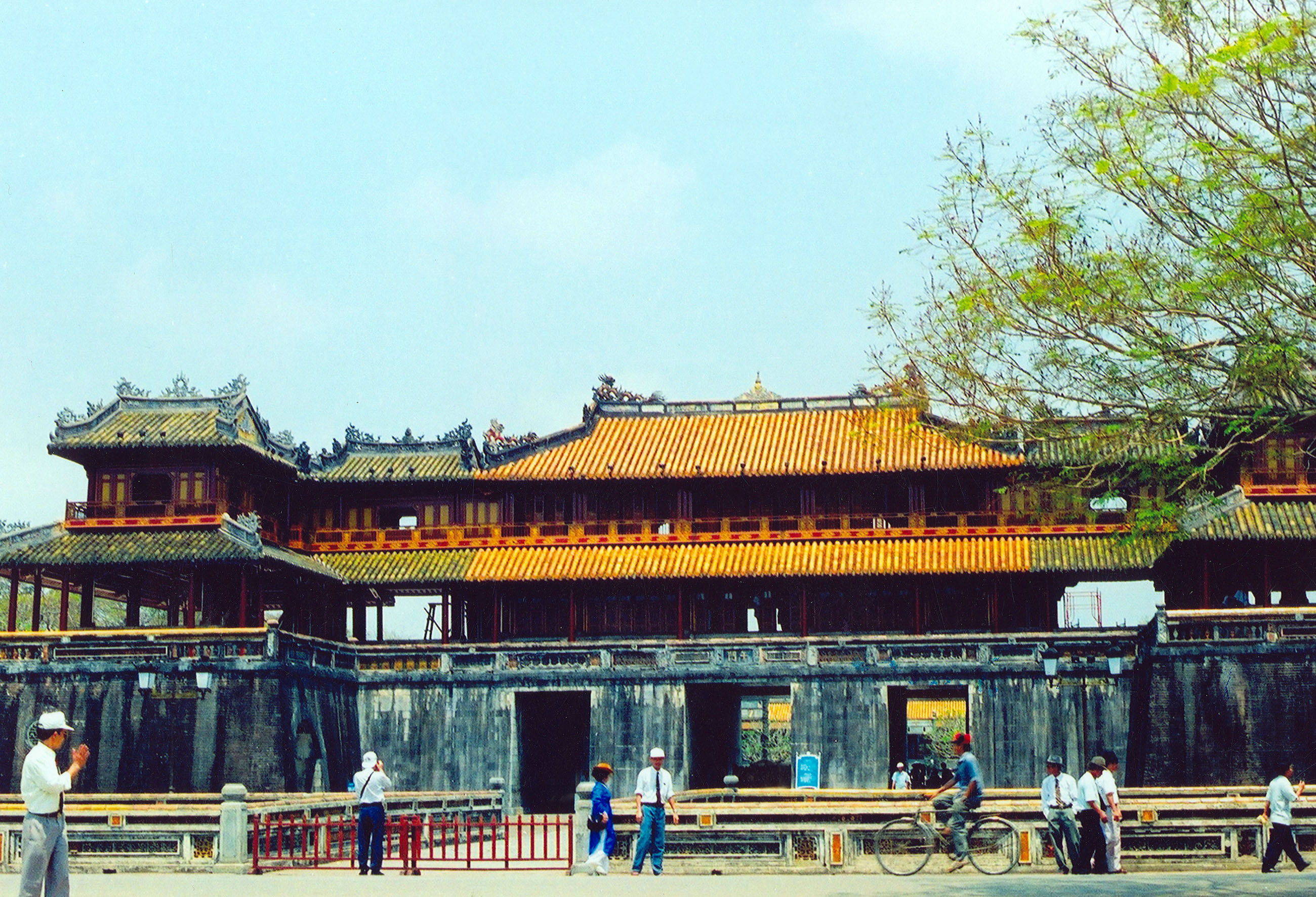 Day 7: Hue city tour (B/L/D)
Day 7: Hue city tour (B/L/D)Meals: Breakfast at hotel, Lunch and Dinner at local restaurant
Accommodations: at hotel
Transfer: Private vehicle
Activities for today: After breakfast, you will first visit the Royal Tomb of King Ming Mang. Then sail the Perfume River by Royal Dragon Boat to the seven-storey Thien Mu Pagoda. Transfer to visit Imperial Citadel with cobbled paths and tour the Forbidden Purple City. Later on, absorb the energy, sounds and odors of the bustling Dong Ba Market. Have dinner at local restaurant. Overnight in Hue.
---------------------------------------------
+ Royal Tomb of King Ming Mang: It is the final resting place of one of the Nguyen Dynasty's staunchest Confucians, whose reign represents the apex of Nguyen power over the country.
+ Perfume River: It is a river that crosses the city of Hue. In the autumn, flowers from orchards upriver from Hue fall into the water, giving the river a perfume-like aroma, hence the soubriquet.
+ Thien Mu Pagoda: Built in 1601 between a river and a pine forest, the Thien Mu Pagoda ("Heavenly Lady Pagoda") in Hue is one of the oldest and prettiest religious buildings in the country.
+ Imperial Citadel: It is comparatively modern in European terms. Built over thirty years in the early part of the 19th century, the Citadel encompasses three ‘courts’ covering a total of 6 km.
+ Forbidden Purple City: Following the design of the Forbidden City in China yet with distinctive inspiration, Hue proudly holds this site as its major attractions luring world-wide Vietnam tours fans.
+ Dong Ba Market: one of the romantic Hue's symbols. What consists in the attraction towards this market is the preservation of ancient distinctiveness. Tourists can see all the typical features of a traditional Vietnamese market.
-
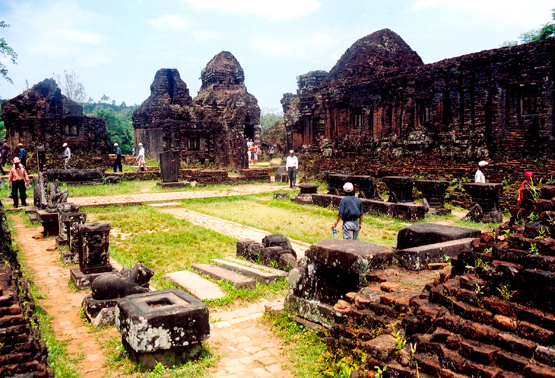 Day 8: Hue - Hoi An – My Son Holy Land (B/L)
Day 8: Hue - Hoi An – My Son Holy Land (B/L)Meals: Breakfast at hotel, Lunch at local restaurant
Accommodations: at hotel
Transfer: Private vehicle
Activities for today: Have breakfast at hotel. In the morning, take a private car from Hue to Hoi An (about 125km - take about 3 hours). Early lunch and drive to My Son Holy Land – one of the world heritage sites of Vietnam. Back to Hoi An for beach relax or on the bank of Thu Bon river or go shopping around. Overnight in Hoi An.
---------------------------------------------
+ Hoi An formerly known as Fai-Fo or Faifoo, is a city with a population of approximately 120,000 in Vietnam's Quảng Nam Province and noted since 1999 as a UNESCO World Heritage Site.
Old Town Hội An, the city's historic district, is recognized as an exceptionally well-preserved example of a Southeast Asian trading port dating from the 15th to the 19th century, its buildings and street plan reflecting a blend of indigenous and foreign influences. Prominent in the city's old town, is its covered "Japanese Bridge," dating to the 16th-17th century.
+ My Son Holy Land: is a cluster of abandoned and partially ruined Hindu temples in Vietnam, constructed between the 4th and the 14th century AD by the kings of Champa (Chiêm Thành in Vietnamese). The temples are dedicated to the worship of the god Shiva, known under various local names, the most important of which is Bhadreshvara.
Mỹ Sơn is located near the village of Duy Phú, in the administrative district of Duy Xuyên in Quảng Nam Province in Central Vietnam, 69 km southwest of Da Nang, and approximately 10 km from the historic town of Trà Kiệu. The temples are in a valley roughly two kilometres wide that is surrounded by two mountain ranges.
From the 4th to the 14th century AD, the valley at Mỹ Sơn was a site of religious ceremony for kings of the ruling dynasties of Champa, as well as a burial place for Cham royalty and national heroes. It was closely associated with the nearby Cham cities of Indrapura (Đồng Dương) and Simhapura (Trà Kiệu). At one time, the site encompassed over 70 temples as well as numerous stele bearing historically important inscriptions in Sanskrit and Cham.
-
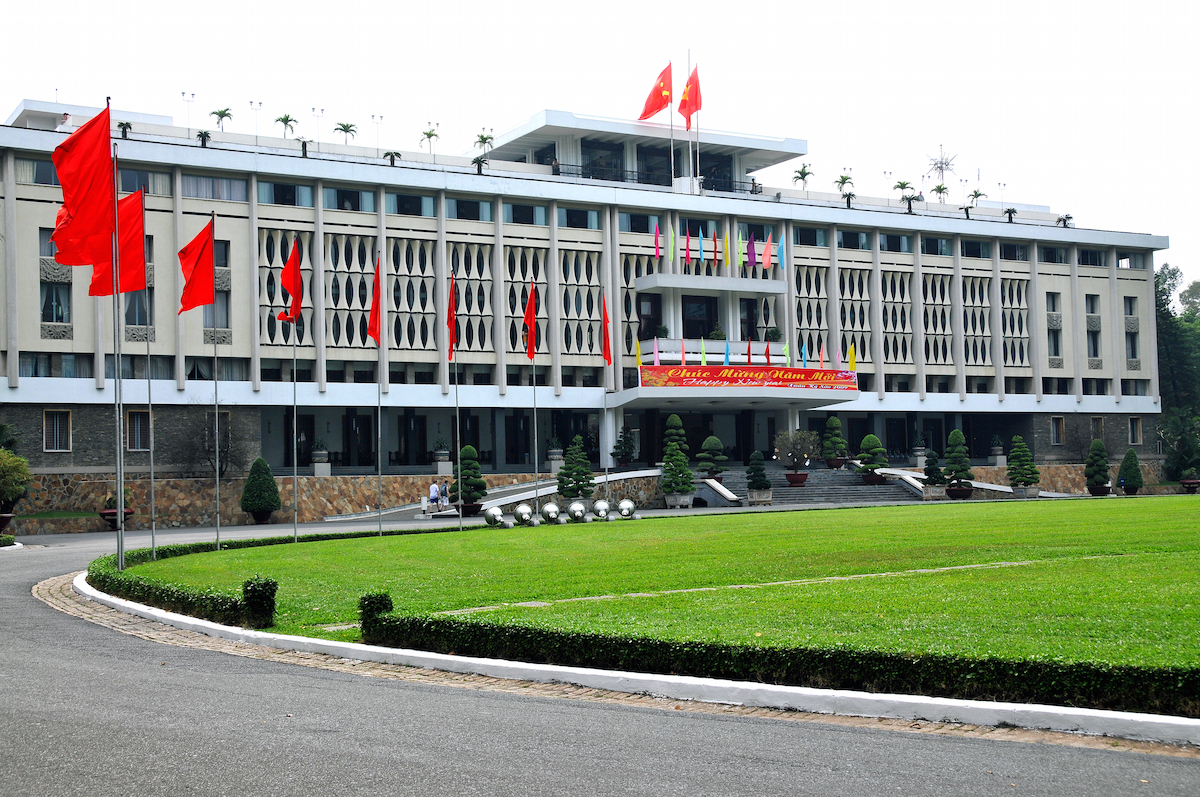 Day 9: Hoian – Danang - Ho Chi Minh (B) by flight
Day 9: Hoian – Danang - Ho Chi Minh (B) by flightMeals: Breakfast at hotel
Accommodations: at hotel
Transfer: Private vehicle and flight by Vietnam airline
Activities for today: Have breakfast at hotel, free time on beach until transfer to Danang airport taking afternoon flight to Ho Chi Minh city. Free to explore the city and overnight in Ho Chi Minh city.
---------------------------------------------
+ Ho Chi Minh City (Vietnamese: Thành phố Hồ Chí Minh); also known by its former name of Saigon (Vietnamese: Sài Gòn), is the most populous city in Vietnam with a population of 8.4 million (13 million in the metropolitan area) as of 2017. Located in southeast Vietnam, the metropolis surrounds the Saigon River and covers about 2,061 square kilometres (796 square miles).
Under the name Saigon, it was the capital of French Indochina from 1887 to 1902 and again from 1945 to 1954. Saigon would later become the capital of South Vietnam from 1955 until its fall in 1975. On 2 July 1976, Saigon merged with the surrounding Gia Định Province and was officially renamed Ho Chi Minh City after revolutionary leader Hồ Chí Minh (although the name Sài Gòn is still widely used).
Ho Chi Minh City is the most visited city in Vietnam, with 6.3 million visitors in 2017. Many of the city's landmarks which are well known to international visitors include the Bến Thành Market, Ho Chi Minh City Hall, Notre-Dame Cathedral Basilica of Saigon, Independence Palace and the Municipal Theatre. The main passenger airport serving the metropolitan area is Tan Son Nhat International Airport, it is the busiest airport in Vietnam handling 36 million passengers in 2017.
+ Vietnam Airlines (Vietnamese: Hãng Hàng không Quốc gia Việt Nam) is the flag carrier of Vietnam. The airline was founded in 1956 and later established as a state-owned enterprise in April 1989. Vietnam Airlines is headquartered in Long Biên District, Hanoi, with hubs at Noi Bai International Airport and Tan Son Nhat International Airport. The airline flies to 64 destinations in 17 countries, excluding codeshared services.
Vietnam Airlines became a member of SkyTeam in June 2010, making it the first Southeast Asian carrier to have joined that alliance.
-
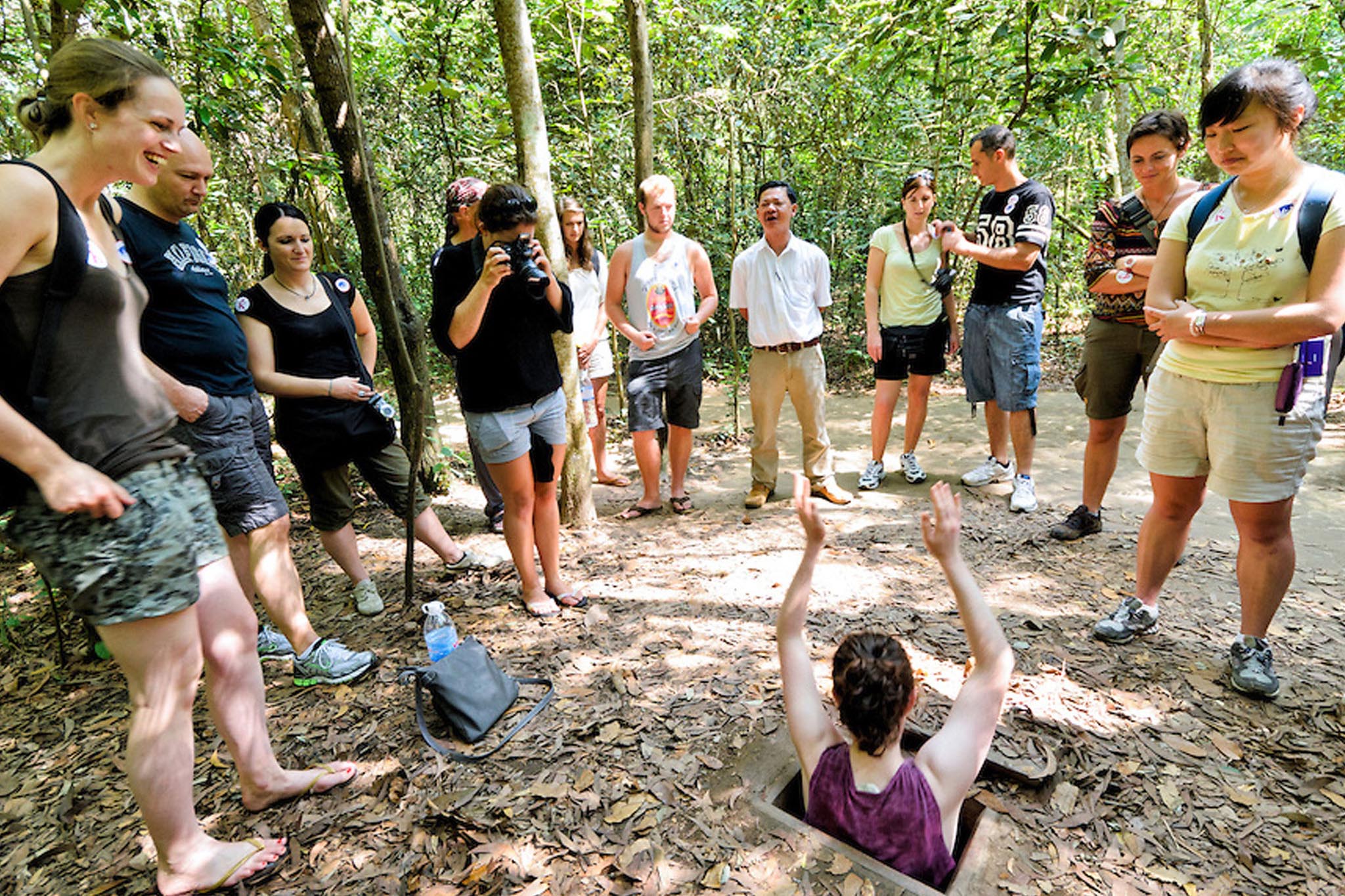 Day 10: Hochiminh - Cu Chi tunnel – city tour (B/L)
Day 10: Hochiminh - Cu Chi tunnel – city tour (B/L)Meals: Breakfast at hotel and Lunch at local restaurant
Accommodations: at hotel
Transfer: Private vehicle
Activities for today: After breakfast at hotel, 08:00 drive to visit Cu Chi tunnel network constructed by Vietnamese fighters during the Vietnam War. After tour drive back to Hochiminh for lunch, then tour begins with a visit to Reunification Palace, War Museum, Notre Dame Cathedral, Ben Thanh market. Overnight in Ho Chi Minh City.
---------------------------------------------
+ Cu Chi Tunnels: This tunnel system was established and used by the Vietcong during the war of independence. From 1988, two sections of tunnels have been open for Vietnam tours visitors. This gigantic underground network connects villages around, making it a wonderful destination for all kinds of Vietnam tours.
+ Notre Dame Cathedral: Constructed by the French in the 1800s, the Notre Dame Cathedral in Ho Chi Minh City appears strangely out of place with its Gothic and Roman-style architecture. Twin towers reaching to 190 feet capture the interest of people strolling by.
+ Reunification Palace: Reunification Palace formerly known as Independence Palace, built on the site of the former Norodom Palace, is a landmark in Ho Chi Minh City. It was the home and workplace of the President of South Vietnam during the Vietnam War.
+ War Museum: War Remnants operated by the Vietnamese government, the museum was opened in September 1975. The museum comprises a series of eight themed rooms in several buildings, with period military equipment located within a walled yard.
+ Ben Thanh Market: The market is one of the earliest surviving structures in Saigon and one of symbols of Ho Chi Minh City, popular with tourists seeking local handicrafts, textiles and souvenirs, as well as local cuisine.
-
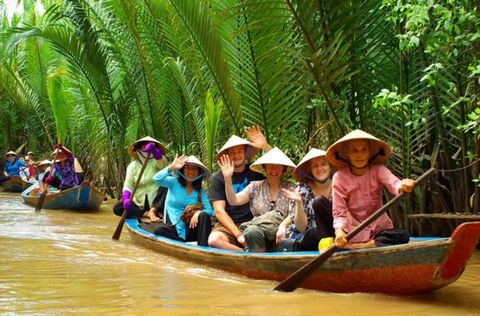 Day 11: Ho Chi Minh - Mekong delta- Ho Chi Minh (B/L)
Day 11: Ho Chi Minh - Mekong delta- Ho Chi Minh (B/L)Meals: Breakfast at hotel and Lunch at local restaurant
Accommodations: at hotel
Transfer: Private vehicle and private boat trip
Activities for today: Have breakfast at hotel, 08:00AM drive to My Tho (about 70-75km), on arrival, get on a private boat cruising along small creek to Mekong River estuary, to Phoenix Island. The motorized boat cruises more along natural creeks and quiet village in Ben Tre Province. Visit orchards, bee - keeping farm, taste natural honey and honey wine, enjoy tropical fruit, traditional music, wonder around a distillery, explore the local coconut candy production process, taste candy & coconut pulp. Overnight in Ho Chi Minh.
---------------------------------------------
+ My Tho is the capital city, center of economics, education and technology of Tiền Giang Province, located in the Mekong Delta region of South Vietnam. The majority ethnic group is the Kinh, and some of the Chinese, the Cham and the Khmer. Boat rides on the Mỹ Tho River are popular with tourists, and the city is known for hủ tiếu Mỹ Tho, a type of rice noodle soup.
-
 Day 12: Ho Chi Minh – Phnom Penh (B/L/D) by flight
Day 12: Ho Chi Minh – Phnom Penh (B/L/D) by flightMeals: Breakfast at hotel, Lunch and Dinner at local restaurant
Accommodations: at hotel
Transfer: Private vehicle and Vietnam airline
Activities for today: After breakfast at hotel, we will transfer to airport; take the flight to Phnom Penh. Our guide and coach will pick up at Phnom Penh International airport then transfer to hotel for check in. Lunch at the local restaurant.
Afternoon, transfer to visit Royal Palace, Silver Pagoda, Preahkeo Morokot, National Museum and Central Market. Dinner at the local & overnight at hotel in Phnom Penh.---------------------------------------------
+ The Royal Palace is a complex of buildings which serves as the royal residence of the king of Cambodia. The Kings of Cambodia have occupied it since it was built in the 1860s, with a period of absence when the country came into turmoil during and after the reign of the Khmer Rouge.
+ Wat Preah Keo Morakot (Silver Pagoda) is located in the southern portion of the Royal Palace complex. The pagoda was formerly known as Wat Uborsoth Rotannaram because it is where the King worshiped, prayed and practiced every Buddhist Silas Day. In the additional, the royal family and officials also held Buddhist ceremonies there.This pagoda has no monks.
+ The National Museum of Cambodia in Phnom Penh is Cambodia's largest museum of cultural history and is the country's leading historical and archaeological museum.
+ Vietnam Airlines (Vietnamese: Hãng Hàng không Quốc gia Việt Nam) is the flag carrier of Vietnam. The airline was founded in 1956 and later established as a state-owned enterprise in April 1989. Vietnam Airlines is headquartered in Long Biên District, Hanoi, with hubs at Noi Bai International Airport and Tan Son Nhat International Airport. The airline flies to 64 destinations in 17 countries, excluding codeshared services.
Vietnam Airlines became a member of SkyTeam in June 2010, making it the first Southeast Asian carrier to have joined that alliance
-
 Day 13: Phnom Penh – Siem Reap (B/L) by flight
Day 13: Phnom Penh – Siem Reap (B/L) by flightMeals: Breakfast at hotel, Lunch at local restaurant
Accommodations: at hotel
Transfer: Private vehicle & Cambodia airline
Activities for today: After breakfast at hotel, then transfer to Phnom Penh International airport for flight to Siem Reap, arrival to transfer to check in hotel. Lunch at the local.
Afternoon, transfer to visit the famous temple of Cambodia, Angkor Wat and take a romantic view Sun Set from the top of Bakheng Hill. overnight at hotel in Rep.----------------------------------------------
+ Angkor Wat: Angkor Wat is the largest and most breathtaking monument at Angkor. Built as the funerary temple for Suryavarman II, who ruled from 1112 to 1152, Angkor never fails to reward the Cambodia tour fans with its grand scale, surreal bas reliefs and unbelievable attention to detail.
+ Cambodia Angkor Air is the national flag carrier airline of Cambodia, with its corporate headquarters and main hub in Phnom Penh.
-
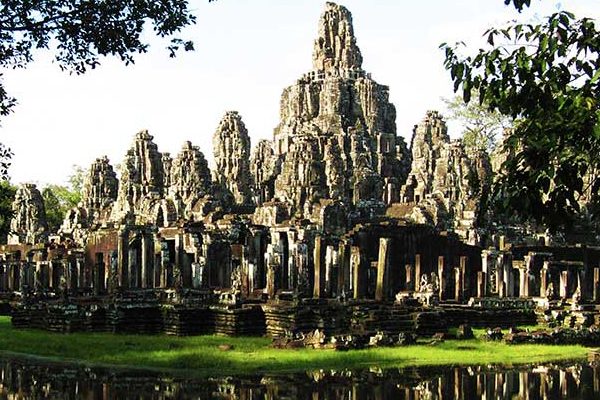 Day 14: Siem Reap – Angkor Ruins (B/L)
Day 14: Siem Reap – Angkor Ruins (B/L)Meals: Breakfast at hotel, Lunch at local restaurant
Accommodations: at hotel
Transfer: Private vehicle
Activities for today: Breakfast at hotel, transfer to continue our exploration of Angkor - visit the famous South Gate of Angkor Thom, Bayon temple, Baphoun, Terrace of Elephants, Terrace of Leper King and Phimean Akas temple. After lunch other Angkor Ruins such as Chao Say Tevoda, Takeo and Ta prhom temple. Overnight in Siem Reap.
---------------------------------------------
+ South Gate of Angkor Thom: The south gate of Angkor Thom is 7.2 km north of Siem Reap, and 1.7 km north of the entrance to Angkor Wat. The walls, 8 m high and flanked by a moat, are each 3 km long, enclosing an area of 9 km2. You can see the giant statues in line at the both sides of the gate, gods in a line and the other are devils.
+ Bayon Temple: It is a well-known and richly decorated Khmer temple at Angkor in Cambodia. The Bayon's most distinctive feature is the multitude of serene and massive stone faces on the many towers which jut out from the upper terrace and cluster around its central peak. The temple is known also for two impressive sets of bas-reliefs, which present an unusual combination of mythological, historical, and mundane scenes.
+ Elephants Terrace: Elephants Terrace was used by Angkor's king Jayavarman VII as a platform from which to view his victorious returning army. It was attached to the palace of Phimeanakas, which only a few ruins remain.
+ Ta Keo Temple: It is a temple-mountain, possibly the first to be built entirely of sandstone by Khmers. Like Pre Rup, it has five sanctuary towers arranged in a quincunx, built on the uppermost level of five-tier pyramid consisting of overlapping terraces (a step pyramid ), surrounded by moat, as a symbolic depiction of Mount Meru. Its particularly massive appearance is due to the absence of external decorations, as carving had just begun when the works stopped, besides an elaborate use of perspective effects. It is considered an example of the so-called Khleang style.
+ Ta Prohm Temple: The photogenic and atmospheric combination of trees growing out of the ruins and the jungle surroundings have made it one of Angkor's most popular temples with visitors. It is famous because of the film "Tomb Raider" also.
-
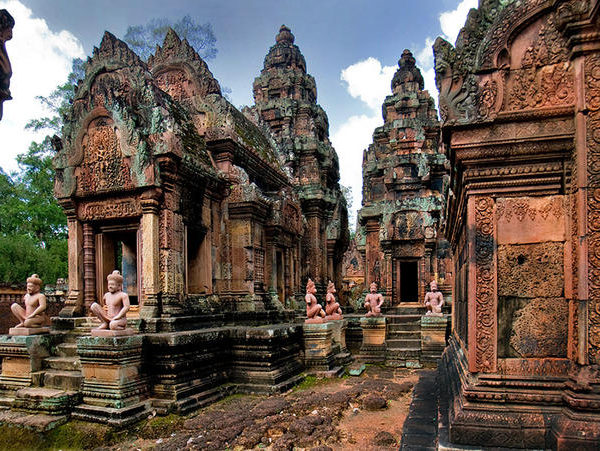 Day 15: Siem Reap - Departure (B/L)
Day 15: Siem Reap - Departure (B/L)Meals: Breakfast at hotel, Lunch at local restaurant
Accommodations: N/A
Transfer: Private vehicle
Activities for today: Morning breakfast at hotel, then transfer to visit Chantier Ecole-Artisant d’Angkor, the place are Ministry of Education, & was create in 1992 and this place renowned woodworking, stone carving and polychrome training center and workshops. Free tours of the classes and workshops offer glimpse Cambodian artistry. Lunch at the local restaurant. Afternoon, do shopping at old market and some souvenir shop till suitable time to transfer to the airport for flight departure. End of services.
-----------------------------------------------
+ Chantier Ecole-Artisant d’Angkor: is a Cambodian social business enterprise that was set up in 1992 to revive traditional Khmer craftsmanship and to provide education and well-being to young Cambodians from impoverished backgrounds.
The students at Artisans Angkor not only learn traditional wood and stone-carving techniques but also how to produce traditional silk paintings and lacquer ware. The products made by these talented young Cambodians are sold at a shop which is situated in the same building as the school. From silk fabrics and garments, stone and wood carving as well as lacquer ware, these products are the perfect souvenirs from a visit to Cambodia.
The profits that the shop make are being used to fund the project and to bring more young Cambodians into the training program. Free guided tours explaining traditional techniques are available daily.
Rates vary frequently depending on group size, travel time, accommodation level, transportation and special touring requirements! Please contact us at [email protected] to get the best possible price.
- Private car
- Private VIP boat in Halong
- Boat trip in Mekong
- English speaking tour guide at each destination
- Accommodation with daily breakfast (Check in at 14:00, check out at 12:00)
- Meals as indicated (B=Breakfast, L=Lunch, D=Dinner)
- 06 Domestic flight tickets within Indochina (Vientaine – Luanprabang – Hanoi – Hue – Ho Chi Minh – Phnom Penh – Siem Reap)
- Airport tax included
- Daily bottle of mineral water.
- All activities mentioned
- All service charge and government tax
- Insurance (Highly recommend to take your own insurance before your departure)
- Personal expenses
- Visa fee
- Drinks
- International flight tickets
- Tips
- Early checking and late check-out at hotels
- Single room
-
Day 1: Vientiane - Arrival (D)
-
Day 2: Vientiane – Luang Prabang (B/L) by flight
-
Day 3: Luang Prabang – Pak Ou cave (B/L)
-
Day 4: Luang Prabang - Hanoi (B/L/D) by flight
-
Day 5: Hanoi – Halong Bay - Hanoi (B/L)
-
Day 6: Hanoi city tour - Hue (B/L) by flight
-
Day 7: Hue city tour (B/L/D)
-
Day 8: Hue - Hoi An – My Son Holy Land (B/L)
-
Day 9: Hoian – Danang - Ho Chi Minh (B) by flight
-
Day 10: Hochiminh - Cu Chi tunnel – city tour (B/L)
-
Day 11: Ho Chi Minh - Mekong delta- Ho Chi Minh (B/L)
-
Day 12: Ho Chi Minh – Phnom Penh (B/L/D) by flight
-
Day 13: Phnom Penh – Siem Reap (B/L) by flight
-
Day 14: Siem Reap – Angkor Ruins (B/L)
-
Day 15: Siem Reap - Departure (B/L)
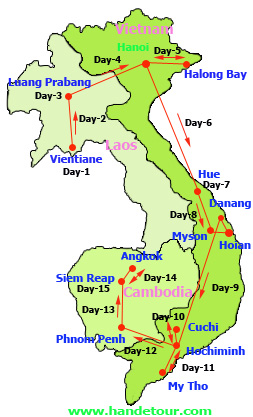
1. We are a real local tour operator and we understand our country more than others.
2. We are a legal company authorized by Vietnam Administration Of Tourism # 01-380
3. We are an official member of PATA # 6989, VITA # 2436, ASTA # 900169082, VCCI # 6178
4. We design your own itinerary without any charges, no matter how many changes.
5. We reply your request within 01 working day to save your valued time.
6. We provide qualified staff, experienced tour guide, well-maintained vehicles, good restaurants, best hotels
7. We only focus on high quality and luxury travel services to ensure our standard.
8. Listen to our customers' saying about us to see how they are satisfied with our services.
Similar Tours
